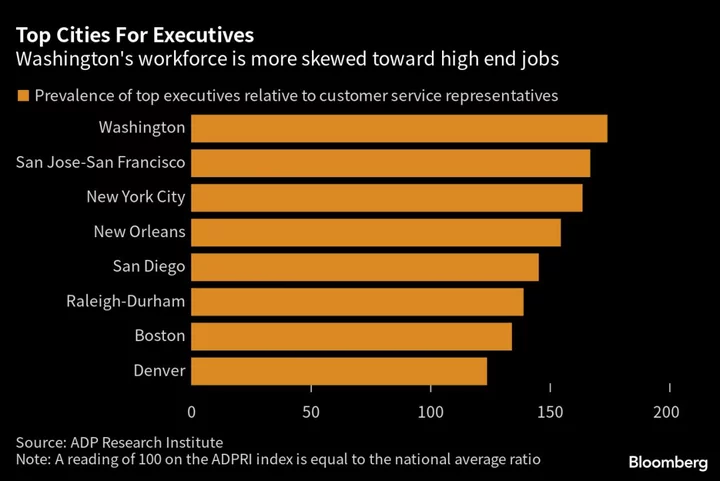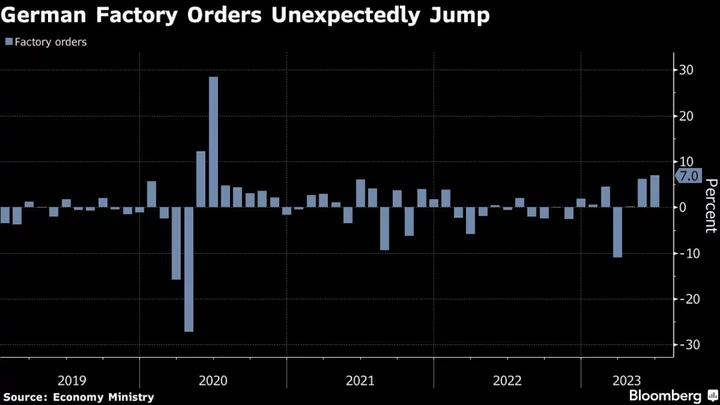The US is becoming increasingly split between high-priced cities where the rich and powerful congregate and more affordable locales that offer jobs that can be done from anywhere, according to a new study.
The report from ADP Research Institute found that jobs that don’t pay enough to cover the cost of housing in places like New York, Washington and San Francisco have been moving to less expensive places like Orlando, Phoenix and Las Vegas. While the survey data ends in 2021, the trends that it documents have likely extended, thanks to the sustained viability of remote work.
The study analyzed the ratio of C-suite executives to customer service representatives and found that it has shifted sharply — with the former group increasingly clustered in expensive cities, while the latter gathered in more affordable ones. Denver and Austin, for example, have seen a growing concentration of senior executives, policy makers and other influential roles in their workforce.
“What is striking was the meteoric rise of tech centers like Austin and Raleigh,” said economist Issi Romem, a research fellow at ADPRI and author of the study, in an interview. “They’re pulling in populations from expensive coastal cities. But overall what we’re seeing is that those in the most pivotal positions who have wealth and influence over the economy are concentrated in those coastal cities even more so than in the past.”
The ADPRI report illustrates how remote work has spurred a new segmentation of the US workforce by allowing people, and even entire industries, to move to different areas of the country, a phenomenon Romem dubs “domestic offshoring.”
‘Growing Divide’
Many jobs that once were anchored to an employer’s location can now be done in offices and homes around the country. About 40% of full-time US employees work from home at least part of the week, according to data from a team of economists including Stanford University’s Nicholas Bloom, and it’s more common in major cities than smaller towns.
As workers quit expensive cities, they leave behind a smaller workforce “that’s heavily concentrated with executive decision-makers and other people who are highly paid,” Romem wrote in the report. “This growing economic and geographic divide threatens to limit opportunity for people in lower-cost regions and could have social and political consequences.”
The US has for years seen widening gaps between the haves and the have-nots, which have worsened of late as high inflation and the Federal Reserve’s most aggressive interest-rate hike cycle in a generation have filtered down to households that were already struggling to get by. Those gaps, in turn, can fuel political polarization.
Read More: Big Cities Lure Smart People. Don’t Fight It, Fed Economists Say
The ADP Research Institute tracked the whereabouts of top executives with those of customer-service representatives using so-called location quotients, which determine if a job or industry is more or less common in a particular place compared with the national average. Call-center workers were chosen as a good proxy for roles that can now be performed just about anywhere.
The shift was apparent before the pandemic but — like many workforce trends — has accelerated since then. “Soaring housing costs and declining affordability are increasingly preventing low-wage earners from living in some of those cities, forcing them to find new places to live and work, and forcing companies to think harder about where work is performed,” Romem wrote in the report.
As America’s high-end labor becomes concentrated in so-called “superstar cities,” those living elsewhere could experience less social and economic mobility, the report concluded.
“I think this says a lot about where one’s opportunities lie,” Romem said. “If you are a customer service rep, or working in that realm, you will find most of your opportunities away from those coastal cities and that will influence your life, who your peers are, and the opportunities your children have.”









